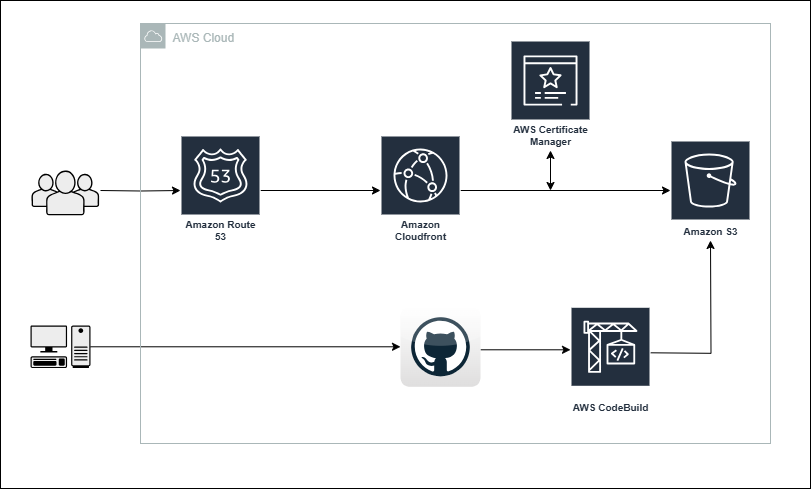In the rapidly evolving FinTech landscape, global presence and immediate access are paramount. Our client, a burgeoning FinTech innovator, sought to launch a new corporate website primarily dedicated to introducing their services to a worldwide audience. Their core requirements were clear: the website needed to be statically rendered for optimal performance and security, yet allow for agile development and content updates. Crucially, it demanded high availability across all major regions and ultra-low latency delivery to ensure an exceptional user experience, regardless of geographic location.
In today’s global digital landscape, a company’s website is its most crucial storefront. Our client, a burgeoning FinTech innovator, sought to launch a new corporate website primarily dedicated to introducing their services to a worldwide audience. it’s about delivering an experience that’s instant, reliable, and available everywhere. But how do you achieve that perfect blend of agility, performance, and global reach?
The Challenge: Beyond Just “Having a Website”
mission was clear: launch an introductory website for their financial services that would resonate with a worldwide audience. This wasn’t just any brochure site; it demanded:
- Developer Efficiency: A streamlined workflow for building and deploying marketing content and interactive elements. The ability to rapidly update service information without complex deployments.
- Guaranteed global availability: Downtime was unacceptable for a financial services provider.
- Ultra-Low Latency: Sub-second load times to ensure immediate engagement and convey their innovative edge. A sluggish website could deter potential clients and diminish their brand’s perception of innovation.
- Enhanced Security: Minimizing the attack surface by serving pre-generated static files was a key security objective.
The Solution: A Modern Static-First Architecture with Next.js on AWS
To meet these exacting demands, our team designed and implemented a robust, globally distributed website architecture leveraging a powerful combination of AWS services and Next.js framework for frontend development. This approach allowed us to pre-render the website into static assets, ensuring unparalleled speed and security.
Key Components of the Solution:
- Next.js for Static Site Generation (SSG): We chose Next.js as the foundational framework. Its powerful Static Site Generation (SSG) capabilities allowed us to pre-build the entire website into highly optimized HTML, CSS, JavaScript, and image files at build time. This meant no server-side processing was needed for each user request, drastically improving load times and reducing server load.
- Amazon S3 for Global Static Content Storage: The generated static files from the Next.js build process were automatically synchronized and stored in an Amazon S3 bucket configured for static website hosting. S3’s inherent durability, scalability, and robust security features made it the ideal, cost-effective repository for the client’s critical web assets.
- Amazon CloudFront for Ultra-Low Latency Delivery: To ensure sub-second load times for users worldwide, we deployed Amazon CloudFront, AWS’s powerful Content Delivery Network (CDN). CloudFront cached the static website content at its global network of Edge Locations. When a user requested the website, CloudFront served the content from the closest Edge Location, drastically reducing latency by minimizing the distance data had to travel.
- Amazon Route 53 for Global High Availability & Smart Routing: Amazon Route 53 was configured as the domain name system (DNS) service. We implemented latency-based routing within Route 53, directing user requests to the CloudFront distribution, which in turn intelligently serves content from the closest Edge Location. The inherent redundancy of CloudFront combined with S3’s multi-AZ architecture ensured unparalleled high availability for the static content.
- GitHub Actions for Automated Deployment: To ensure rapid and consistent updates, we implemented an automated CI/CD pipeline using GitHub Actions. Every time clients team pushes a code change, GitHub Actions automatically builds the Next.js site, pushes the new static files to S3, and invalidates the CloudFront cache, ensuring the latest content is live globally within minutes.
- AWS Certificate Manager (ACM): Integrated seamlessly with CloudFront to provide free SSL/TLS certificates, ensuring secure HTTPS connections for all website traffic, a non-negotiable for a FinTech company.

4. Implementation: Agile Development & Automated Deployment
The implementation involved a streamlined, developer-friendly process:
- Next.js Development: Building the website’s frontend components and pages using Next.js.
- Automated Build Process: Setting up a Continuous Integration (CI) pipeline (e.g., using AWS CodeBuild or a third-party CI/CD tool) to automatically build the Next.js project into static HTML, CSS, and JS files on every code commit.
- S3 Deployment: Configuring the CI pipeline to synchronize the generated static files directly to the designated S3 bucket.
- CloudFront Cache Invalidation: Automating CloudFront cache invalidation upon new deployments to ensure users always received the latest content.
- Route 53 DNS Configuration: Pointing the client’s domain to the CloudFront distribution for global access.
5. Results: Unprecedented Performance and Strategic Advantage
The newly deployed website immediately delivered significant, measurable benefits.
- Global Low Latency: Average page load times dropped to under 1 second for users worldwide, regardless of their location, significantly enhancing the user experience and improving SEO.
- Near 100% Availability: By leveraging S3’s inherent durability and CloudFront’s globally distributed network, the website achieved exceptional uptime, crucial for a client in the financial sector.
- Enhanced Security: Serving a purely static website dramatically reduced the attack surface, mitigating common web vulnerabilities associated with dynamic servers and databases.
- Developer Agility: The Next.js framework empowered the development team with a modern, efficient workflow for rapid iteration and content updates.
- Cost Efficiency: The architecture proved highly cost-effective, leveraging the pay-as-you-go model of AWS services, particularly for CDN and storage, which are optimized for static content delivery.
6. Is Your Website Ready for the Global Stage?
This project exemplifies how modern web development frameworks and strategic cloud architecture can overcome complex challenges to deliver superior results. If your business demands a website that is not just present, but performs globally with speed, security, and unwavering availability, a static-first approach with Next.js and AWS might be your next strategic move.